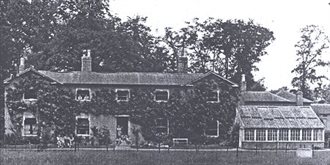Ravensden House
This page was written by Trevor Stewart

Ravensden House in use as a Women's Land Army Training Centre, 1940s
For many years this was the largest house in the village. It has 14 rooms and is a substantial brick built property. At the head of the drive from the Thurleigh Road there is a Lodge once occupied by the coachman and next door to that, two farm workers cottages built in 1866.
The house was constructed in the early 1800s by John Mackay (born 1776), a lawyer, and his relative Charles Campbell (born 1796), an Officer in the Madras Cavalry. Both men had invested heavily in the East India Company and had clearly made rather a lot of money before the crash of the company. They were both deeply involved in the Parliamentary procedures of 1820/1822 when investors attempted to recover their lost finances.
The two men were both recorded as being at Ravensden House in the 1841 Census and also living there was Mackay’s widowed sister Jane Whistler and her family. Mackay must have had some standing as he was listed as a Juror for the County and had been nominated as High Sheriff in 1824. This also indicates that he had been at Ravensden for at least 17 years before 1841.
On 18th October 1800 at St. Georges Church, Hanover Square, London a Captain Webster Whistler, 24th Regiment of Light Dragoons born February 1770, of Fairlight, Sussex, married a Jane Mackay of the parish of St. Georges. When he died in Kensington, on 8th September 1837 his Obituary records ‘’that he left a wife Jane, the sister of Colonel Mackay of Ravensden Park.’’
Mackay and Campbell were also responsible for the construction of the row of cottages on Bedford Road for many years referred to locally as ‘’the boarded row,’’ - because of their timber cladded frontages, but now virtually unrecognisable. Interestingly this small part of the village is also denoted on the early Census documents as ‘’Campbelltown’’ thus giving an indication of who was responsible for the construction. The pair similarly invested in the early local brick industry.
Mackay died at Ravensden in the early months of 1849 and Campbell, as his executor, sold and moved away.
Francis Wythes, who by 1850 had also made a great deal of money from his involvement in the railway industry, purchased the property and moved in with his family in 1851. The Wythes continued their ownership until 1942 when Francis’s son died there.
A Mr. Edmonds then had the house for a short time but when he died it was requisitioned by the government to become the main training Headquarters for the Women’s Land Army in the County. This use continued until 1949 when the whole estate was sold to a Mr. Fairfield. By coincidence he was also a retired Director/Officer of the Indian Railway Company. He farmed the land for many years but let the house as two separate self contained flats.
Both the land and the property were then acquired by E.F. Wootton and Sons and the house has now been returned to use as a single property.